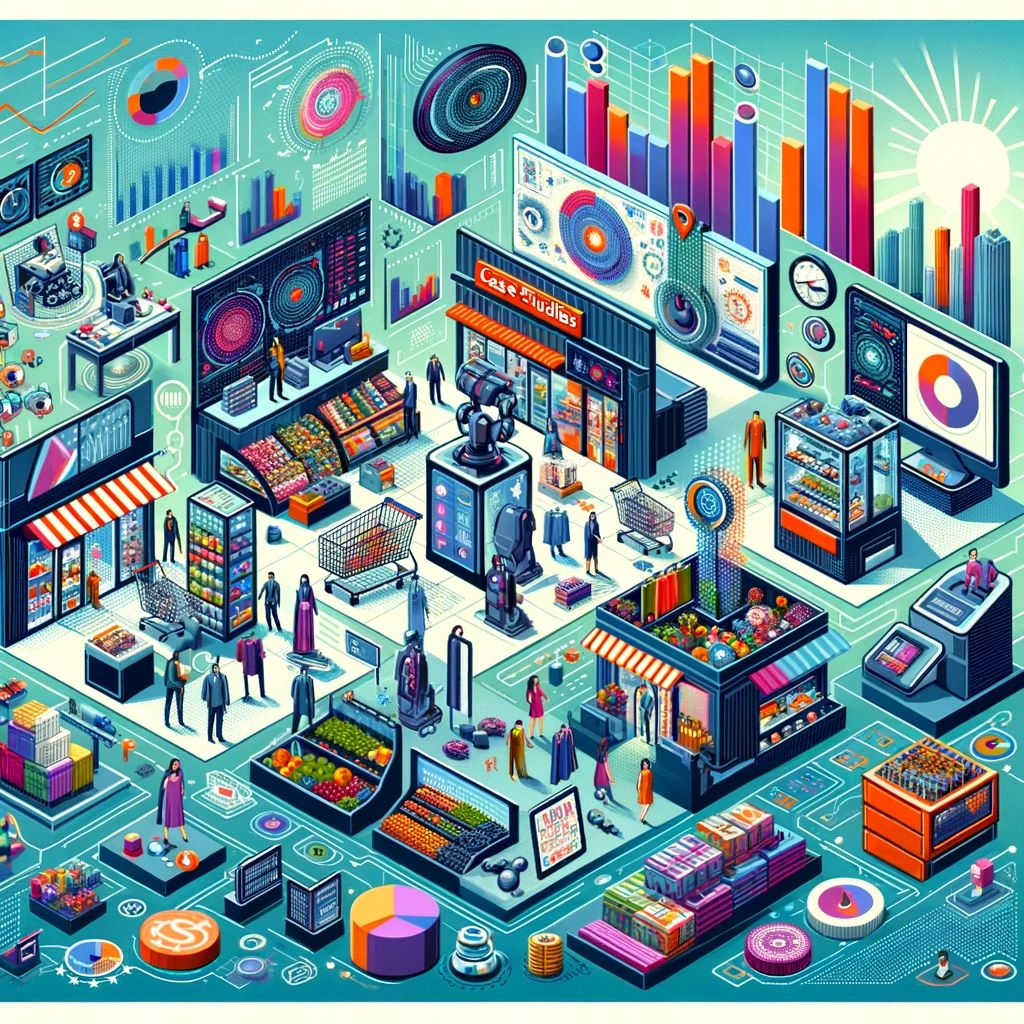Quiz: E-commerce Development History and Key Milestones
Test your knowledge on the evolution of e-commerce with this quiz.
From its early beginnings to the present day, see how well you understand the key milestones and events that have shaped the world of online shopping.
Question 1
What year is considered the birth of e-commerce, marked by the first online transaction?
- A) 1982
- B) 1991
- C) 1994
- D) 1995
Question 2
Which company was one of the first to implement SSL (Secure Sockets Layer) encryption for secure online transactions?
- A) Amazon
- B) eBay
- C) NetMarket
- D) Netscape
Question 3
What was the main product sold by Amazon when it first launched?
- A) Electronics
- B) Books
- C) Clothing
- D) Music CDs
Question 4
eBay, initially launched under a different name, was known as:
- A) AuctionWeb
- B) eShop
- C) OnlineMarket
- D) QuickSell
Question 5
Which technology is credited with revolutionizing the way e-commerce platforms recommend products to users?
- A) Blockchain
- B) Augmented Reality
- C) Artificial Intelligence
- D) Virtual Reality
Question 6
The dot-com bubble burst occurred in which year, leading to the collapse of many internet-based companies?
- A) 1999
- B) 2000
- C) 2001
- D) 2002
Question 7
Alibaba, a major player in e-commerce, originated in which country?
- A) United States
- B) China
- C) India
- D) Germany
Question 8
What significant e-commerce development allows consumers to see how a product looks in their environment before buying it?
- A) 3D Printing
- B) Internet of Things (IoT)
- C) Augmented Reality (AR)
- D) Machine Learning
Question 9
Which of the following has become a critical sales channel for e-commerce businesses, integrating shopping directly into its platform?
- A) Email
- B) Social Media
- C) Television
- D) Radio
Question 10
“Singles’ Day,” the world’s largest online shopping day, was popularized by which e-commerce company?
- A) Amazon
- B) eBay
- C) Alibaba
- D) Shopify
Answers:
- C) 1994
- C) NetMarket
- B) Books
- A) AuctionWeb
- C) Artificial Intelligence
- B) 2000
- B) China
- C) Augmented Reality (AR)
- B) Social Media
- C) Alibaba
How did you do?
This quiz spans the crucial moments and technologies that have contributed to the growth and development of e-commerce, reflecting on how far the industry has come from its inception to becoming a cornerstone of the global economy.
Scenario Analysis: The Future of E-commerce with Emerging Technologies
The rapid evolution of technology continually reshapes the e-commerce landscape, offering new opportunities for innovation and growth.
This scenario analysis explores potential future developments in e-commerce, driven by emerging technologies such as artificial intelligence (AI), blockchain, augmented reality (AR), and the Internet of Things (IoT).
These scenarios envision how these technologies could transform consumer experiences, business models, and the global market.
Scenario 1: Hyper-Personalized Shopping Experiences with AI
Year: 2025
Technology: Artificial Intelligence
Scenario Overview: E-commerce platforms have integrated advanced AI algorithms capable of real-time learning from user interactions.
These platforms now offer hyper-personalized shopping experiences, predicting consumer needs and preferences with unprecedented accuracy.
Impact:
- Consumer Experience: Shoppers receive personalized storefronts that adjust dynamically based on their browsing behavior, past purchases, and even current mood, detected through biometric feedback.
- Business Model: Retailers adopt subscription-based models offering tailored product assortments and personalized delivery schedules.
- Market Dynamics: Competition shifts towards AI-driven insights and customization capabilities, with companies investing heavily in data analytics and consumer behavior research.
Scenario 2: Decentralized Marketplaces with Blockchain
Year: 2027
Technology: Blockchain
Scenario Overview: The proliferation of blockchain technology has led to the emergence of decentralized e-commerce platforms.
These platforms facilitate secure, peer-to-peer transactions without intermediaries, significantly reducing costs and increasing transparency.
Impact:
- Consumer Experience: Buyers and sellers engage in transactions with enhanced trust, thanks to transparent product sourcing and authenticity verification.
- Business Model: Traditional e-commerce giants face competition from decentralized marketplaces, prompting a shift towards blockchain integration for security and efficiency.
- Market Dynamics: The reduction in transaction fees and the ability to conduct cross-border trade more seamlessly open up global markets, particularly benefiting small and medium-sized enterprises (SMEs).
Scenario 3: Immersive Shopping with AR and VR
Year: 2026
Technology: Augmented Reality & Virtual Reality
Scenario Overview: AR and VR technologies have matured, allowing for fully immersive shopping experiences.
Consumers can explore virtual malls, interact with products in 3D, and customize items in real-time before making a purchase.
Impact:
- Consumer Experience: The boundary between online and offline shopping blurs, with consumers enjoying the convenience of online shopping and the tangibility of physical stores.
- Business Model: Retailers invest in virtual showrooms and AR-powered apps, prioritizing immersive content creation to engage customers.
- Market Dynamics: The demand for AR/VR content creation tools and platforms skyrockets, leading to new ventures and collaborations between tech companies and retailers.
Scenario 4: IoT-Driven Automated Commerce
Year: 2028
Technology: Internet of Things (IoT)
Scenario Overview: IoT technology has become deeply integrated into everyday objects, enabling automated commerce.
Smart devices can now predict consumer needs, automatically ordering products before they run out.
Impact:
- Consumer Experience: Shopping becomes a background process for many routine purchases, with smart devices managing inventory and reordering based on usage patterns.
- Business Model: E-commerce platforms and IoT device manufacturers collaborate closely, developing ecosystems where data sharing optimizes supply chains and product offerings.
- Market Dynamics: Companies that can integrate their products with IoT ecosystems gain a competitive edge, leading to partnerships that bridge technology and consumer goods.
Emerging technologies hold the potential to dramatically reshape e-commerce, offering more personalized, secure, and immersive shopping experiences.
While these scenarios envision a future where technology seamlessly integrates with commerce, they also highlight the need for businesses to adapt to these changes proactively.
As these technologies continue to develop, the e-commerce landscape will undoubtedly evolve, presenting new challenges and opportunities for retailers and consumers alike.
Timeline Project: Key Events in the Evolution of E-commerce
This timeline project outlines the significant milestones in the development of e-commerce, tracing its origins from the early experiments in electronic transactions to the sophisticated digital marketplace we know today.
1970s: The Dawn of Electronic Transactions
- 1971/1972: The first online transaction occurs between Stanford and MIT students over ARPANET, involving the sale of marijuana.
- 1979: Michael Aldrich invents online shopping by connecting a modified TV to a computer via a telephone line, creating a teleshopping system.
1980s: Early Foundations
- 1982: France launches Minitel, an online service that precedes the internet, allowing users to make online purchases, check stock prices, and search the telephone directory.
- 1984: Jane Snowball makes the first online home shopping transaction in the UK through the Gateshead SIS/Tesco system.
1990s: The Commercialization of the Internet
- 1991: The internet is opened for commercial use, paving the way for the first e-commerce transactions.
- 1994: Netscape releases the first commercial browser, Navigator, and introduces SSL encryption for secure online transactions. Pizza Hut claims to have sold the first physical good over the internet this year.
- 1995: Amazon is founded by Jeff Bezos as an online bookstore. eBay is also launched by Pierre Omidyar, introducing the concept of online auctions.
2000s: Expansion and Consolidation
- 2000: The dot-com bubble bursts, leading to the failure of many e-commerce startups.
- 2001: Alibaba is founded in China, focusing initially on B2B online marketplaces.
- 2004: Shopify is founded, offering businesses an easy-to-use platform for creating their own e-commerce sites.
- 2005: Amazon introduces Prime, a membership offering free two-day shipping, later expanding to include streaming services.
2010s: Mobile and Social Media Integration
- 2010: The first Cyber Monday sales event takes place, encouraging online shopping through promotions.
- 2011: The term “m-commerce” gains popularity as smartphone usage expands, making mobile devices a key shopping tool.
- 2014: Alibaba’s IPO in the US becomes the largest in history at the time, highlighting the global impact of e-commerce.
- 2015: Instagram launches shoppable posts, marking the start of social media platforms integrating direct e-commerce capabilities.
2020s: The Era of Personalization and AI
- 2020: The COVID-19 pandemic leads to unprecedented growth in e-commerce as consumers turn to online shopping amid lockdowns.
- 2021: Artificial Intelligence and machine learning become central to providing personalized shopping experiences online.
- 2022: Augmented Reality shopping experiences become more mainstream, with platforms allowing users to visualize products in their own space.
Future Projections
- 2025 and Beyond: Predictions include the widespread adoption of blockchain for secure and transparent transactions, the integration of the Internet of Things (IoT) in automating purchases, and the evolution of virtual reality (VR) shopping platforms, offering immersive retail experiences.
This timeline highlights the significant technological innovations and market shifts that have defined the evolution of e-commerce.
From humble beginnings to a cornerstone of the global economy, e-commerce has continually adapted to changing technologies and consumer behaviors, shaping how we live, shop, and interact with the digital world.
Trend Analysis: Current E-commerce Trends and Future Implications
The e-commerce sector is experiencing rapid transformation, driven by technological innovations, evolving consumer expectations, and shifts in the global economic landscape.
This analysis explores current e-commerce trends, their impact on the industry, and potential future implications.
-
Rise of Mobile Commerce (M-commerce)
Current State: M-commerce has become increasingly dominant, with a significant portion of online shopping transactions now occurring on mobile devices.
This shift is fueled by the global proliferation of smartphones and improved mobile internet connectivity.
Implications for the Future: The importance of mobile-optimized websites and apps will continue to grow.
Retailers will need to focus on creating seamless mobile shopping experiences, leveraging technologies like mobile wallets and augmented reality (AR) to enhance user engagement and convenience.
-
Social Commerce Expansion
Current State: Social media platforms are increasingly integrating e-commerce functionalities, allowing users to shop directly through social media apps.
Influencer marketing and shoppable posts are becoming key drivers of consumer discovery and purchase decisions.
Implications for the Future: Social commerce is set to become a crucial sales channel for brands.
The blending of content and commerce will necessitate innovative social media strategies, focusing on community building and interactive shopping experiences.
-
Personalization and AI-driven Shopping Experiences
Current State: E-commerce platforms are using AI and machine learning to offer personalized shopping experiences.
From product recommendations to personalized marketing messages, AI is enabling a more tailored approach to online shopping.
Implications for the Future: Personalization will evolve beyond simple recommendations, incorporating real-time data analysis to anticipate consumer needs and offer hyper-personalized experiences.
Privacy considerations will become increasingly important as consumers demand more control over their data.
-
Sustainability and Ethical Shopping
Current State: Consumers are becoming more conscious of the environmental and ethical implications of their purchasing decisions.
This has led to a rise in demand for sustainable products and transparent supply chains.
Implications for the Future: Sustainability will become a competitive differentiator for brands.
Retailers will need to integrate sustainable practices throughout their operations, from sourcing and production to packaging and logistics, and communicate these efforts transparently to consumers.
-
Omnichannel Retailing
Current State: The distinction between online and offline shopping is blurring, with consumers expecting a seamless shopping experience across all channels.
Retailers are adopting omnichannel strategies to provide a cohesive customer journey, from online browsing to in-store purchases.
Implications for the Future: The integration of digital and physical retail will deepen, with technologies like AR, IoT, and smart stores enhancing the omnichannel experience.
Retailers will leverage data from multiple touchpoints to offer personalized in-store experiences and efficient online-to-offline (O2O) services.
-
Adoption of Blockchain for Transparency and Security
Current State: Blockchain technology is being explored for its potential to enhance transparency and security in e-commerce transactions.
Applications include supply chain tracking, counterfeit prevention, and secure payments.
Implications for the Future: As blockchain technology matures, its adoption in e-commerce could become more widespread, leading to more transparent supply chains and enhanced consumer trust.
Regulatory developments will play a key role in facilitating blockchain’s adoption in retail.
The current trends in e-commerce reflect a dynamic industry at the intersection of technology, consumer behavior, and global challenges.
As these trends evolve, they will shape the future of retail, requiring businesses to adapt and innovate continually.
The successful retailers of tomorrow will be those that can leverage technology to meet consumer expectations for convenience, personalization, and sustainability, all while navigating the complexities of a rapidly changing digital landscape.
Innovation Proposal: EcoChain – A Blockchain-Powered E-commerce Platform for Sustainable Shopping
Executive Summary
In response to the growing consumer demand for sustainability and transparency in the e-commerce sector, we propose “EcoChain,” a revolutionary blockchain-powered platform designed to promote sustainable shopping.
EcoChain aims to connect conscious consumers with eco-friendly and ethically sourced products, leveraging blockchain technology to ensure transparency and authenticity in every transaction.
This proposal outlines the concept, features, and potential impact of EcoChain on the future e-commerce market.
Concept Overview
EcoChain is an e-commerce platform that integrates blockchain technology to provide a transparent and secure shopping experience focused on sustainability.
By verifying the origin, materials, and supply chain practices of products, EcoChain offers consumers peace of mind and an easy way to make responsible purchasing decisions.
Key Features
- Blockchain-Verified Listings: Each product on EcoChain comes with a blockchain-verified profile detailing its journey from production to sale, including material sourcing, manufacturing processes, and environmental impact assessments.
- Sustainability Score: Products are evaluated based on their environmental and social impact, receiving a sustainability score that helps consumers make informed choices.
- Eco-Rewards Program: Consumers earn Eco-Points for their purchases, which can be redeemed for discounts or donated to environmental causes, incentivizing sustainable shopping behaviors.
- Decentralized Marketplace: EcoChain operates as a decentralized platform, reducing operational costs and passing the savings onto both consumers and producers, encouraging the adoption of sustainable practices.
- Smart Contracts for Supply Chain Transparency: Utilizing smart contracts, EcoChain automates and secures transactions, ensuring that only products meeting strict sustainability criteria are sold on the platform.
Market Need and Opportunity
The demand for sustainable products is rising, yet consumers often struggle to verify the environmental and ethical claims made by brands.
EcoChain addresses this gap by offering a trustworthy platform where sustainability is not just a claim but a verifiable standard.
This approach not only meets the current market need for transparency but also capitalizes on the opportunity to lead the shift towards more responsible consumption patterns.
Potential Impact
- Promoting Sustainable Consumption: By making it easier for consumers to identify and purchase sustainable products, EcoChain can drive the market towards more environmentally friendly and socially responsible practices.
- Enhancing Supply Chain Transparency: The use of blockchain technology sets a new standard for transparency in e-commerce, potentially influencing broader industry practices.
- Building Consumer Trust: The assurance of authenticity and ethical sourcing can enhance consumer trust in online shopping, potentially increasing overall market participation in e-commerce.
- Supporting Small and Ethical Producers: By providing a platform for small-scale, sustainable producers to reach a wider audience, EcoChain can contribute to economic diversity and sustainability.
Implementation Roadmap
- Phase 1 – Platform Development and Beta Testing: Develop the EcoChain platform and conduct beta testing with a select group of sustainable brands and consumers.
- Phase 2 – Official Launch and Marketing Campaign: Launch the platform officially and initiate a marketing campaign targeting eco-conscious consumers and ethical brands.
- Phase 3 – Expansion and Partnerships: Expand the product range and enter strategic partnerships with environmental organizations and sustainability certification bodies to enhance the platform’s offerings and credibility.
EcoChain represents a forward-thinking solution to the growing demand for sustainable shopping options in the e-commerce sector.
By harnessing the power of blockchain technology for transparency and security, EcoChain aims to transform how consumers shop online, promoting a shift towards more sustainable and ethical consumption patterns.
This innovative platform has the potential to redefine e-commerce, making it not just a marketplace but a movement towards a more sustainable future.
Navigating Market Changes: Strategies for Adapting to the Fast-Paced Evolution of E-commerce
The e-commerce landscape is characterized by rapid changes and intense competition. Businesses must adapt swiftly to remain relevant and competitive.
Here are strategies for navigating these market changes effectively:
-
Stay Informed on Industry Trends
- Regularly monitor industry reports, attend webinars, and participate in e-commerce forums. Understanding emerging trends helps anticipate market shifts and adapt strategies accordingly.
-
Leverage Data Analytics
- Utilize data analytics tools to gain insights into consumer behavior, preferences, and market dynamics. This data-driven approach enables informed decision-making and agile adaptation to market changes.
-
Foster Innovation
- Create a culture of innovation within your organization. Encourage experimentation with new business models, marketing strategies, and customer engagement tactics. Being open to change is crucial for thriving in the evolving e-commerce space.
-
Customer-Centric Approach
- Keep the focus on delivering exceptional customer experiences. Continuously gather feedback and iterate on your offerings to meet changing consumer expectations. Personalization and customer service excellence can set your brand apart.
-
Flexible Supply Chain Management
- Develop a resilient and adaptable supply chain. Partner with multiple suppliers and logistics providers to reduce dependency on a single source, ensuring you can quickly respond to supply chain disruptions or changes in consumer demand.
-
Embrace Omnichannel Strategies
- Adopt an omnichannel approach to retail, providing a seamless shopping experience across online platforms, mobile apps, and physical stores. This strategy caters to the evolving shopping behaviors of consumers.
Overcoming Technological Barriers: Solutions for Keeping Up with Emerging Technologies and Integrating Them into E-commerce Operations
Integrating the latest technologies is crucial for staying competitive in e-commerce, but it can be challenging.
Here are solutions for overcoming these technological barriers:
-
Invest in Continuous Learning
- Allocate resources for training and development programs for your team. Understanding new technologies and their applications in e-commerce is essential for effective integration.
-
Partner with Tech Startups
- Collaborate with technology startups to gain access to innovative solutions and expertise. These partnerships can offer competitive advantages by leveraging cutting-edge technologies.
-
Adopt a Modular Tech Architecture
- Implement a modular technology architecture that allows for the easy addition and removal of components. This flexibility makes it easier to incorporate new technologies as they emerge.
-
Utilize Cloud Computing
- Cloud-based solutions offer scalability, flexibility, and cost-effectiveness, making it easier to adopt new technologies and scale your operations according to demand.
-
Engage in Technology Pilots
- Conduct pilot projects to test new technologies on a small scale before full integration. This approach reduces risk and allows for learning and adjustments.
-
Outsource to Overcome Skill Gaps
- If in-house expertise is lacking, consider outsourcing certain technological functions to specialized agencies or consultants. This can provide access to the necessary skills and knowledge to integrate new technologies successfully.
Adapting to the fast-paced evolution of e-commerce requires a proactive and strategic approach.
By staying informed, fostering innovation, and focusing on customer-centric strategies, businesses can navigate market changes successfully.
Overcoming technological barriers involves continuous learning, flexible tech architecture, and strategic partnerships.
These strategies enable e-commerce businesses to leverage emerging technologies effectively, enhancing their competitiveness and positioning them for future growth.
For those interested in deepening their understanding of e-commerce—from its origins to the current landscape and future predictions—here is a curated list of articles, books, and reports.
These resources provide insights into the technological innovations, market dynamics, and consumer behaviors shaping the world of online retail.
Books
- “The Everything Store: Jeff Bezos and the Age of Amazon” by Brad Stone
- An in-depth look at Amazon’s rise to become a dominant force in global e-commerce, offering insights into the vision and strategies of its founder, Jeff Bezos.
- “New Retail: Born in China Going Global” by Ashley Galina Dudarenok
- This book explores how Chinese tech giants are leading innovations in retail and e-commerce, offering lessons for businesses worldwide.
- “Digital Renaissance: What Data and Economics Tell Us about the Future of Popular Culture” by Joel Waldfogel
- Waldfogel examines how digital technology is transforming the creative industry, including the impact on e-commerce platforms that sell cultural products.
Articles and Reports
- “The Future of Shopping” by Harvard Business Review
- A collection of articles analyzing how technology is changing retail and what the future might hold for e-commerce.
- “Global E-commerce 2023” Report by eMarketer
- This report provides data and insights on e-commerce growth, consumer behaviors, and trends across different regions and sectors.
- “The State of E-commerce 2023” by Shopify
- An annual report discussing the latest trends in e-commerce, including consumer expectations, emerging technologies, and global market shifts.
Websites and Online Resources
- TechCrunch (E-commerce Section)
- Stay updated with the latest news and developments in e-commerce startups, technology innovations, and industry trends.
- Statista (E-commerce)
- A comprehensive source for statistics and data on e-commerce sales, market shares, and consumer behaviors worldwide.
- Forrester’s E-commerce
- Offers market research and reports on e-commerce trends, online consumer behavior, and technology adoption.
Additional Resources
- Google Scholar
- For those interested in academic research, Google Scholar provides access to scholarly articles and papers on e-commerce topics, including consumer psychology, digital marketing, and supply chain management.
- TED Talks (Technology, Entertainment, Design)
- Offers inspirational talks from industry leaders and innovators on the future of technology, business, and how they intersect with e-commerce.
By exploring these resources, readers can gain a comprehensive understanding of the e-commerce sector’s past developments, present challenges, and future opportunities.
This knowledge is invaluable for students, professionals, and anyone interested in the dynamics of online retail and digital marketplaces.














